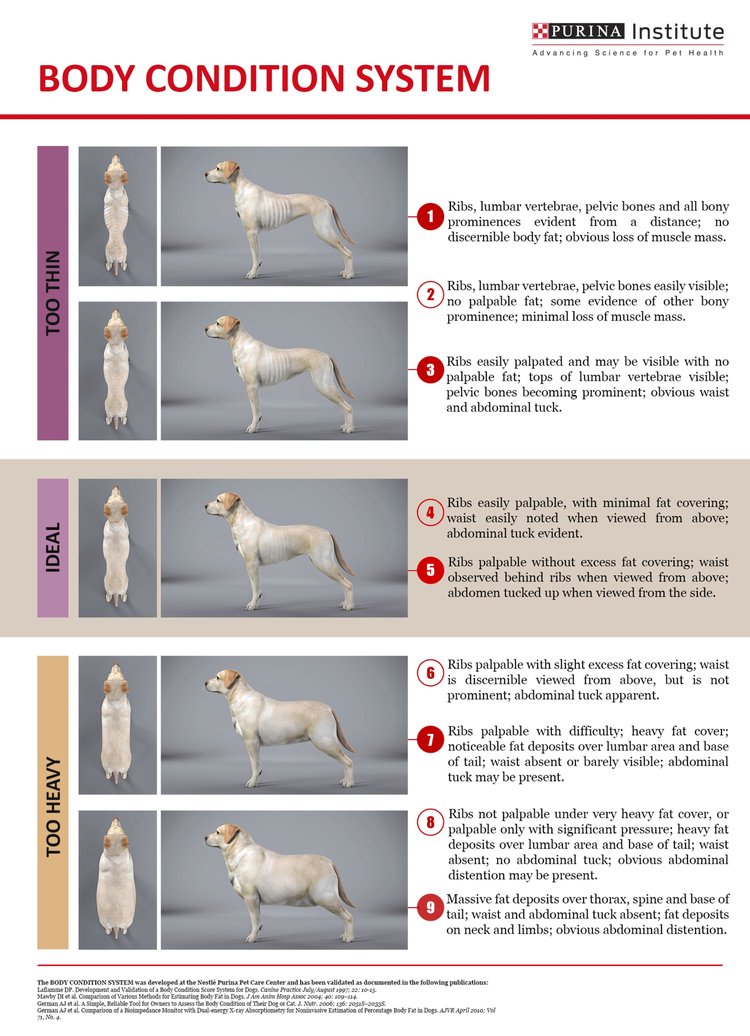When Our Pets are Overweight

Obesity is all too common in our pets, affecting an estimated 55-60% of dogs and cats in the United States. Recognizing & maintaining a healthy weight will help your pet live a better and longer life.
One life-long nutrition study in Labrador Retrievers revealed that lean dogs lived, on average, 1.8 years longer than obese dogs. Obesity is associated with many adverse health conditions, including osteoarthritis, diabetes mellitus, feline lower urinary tract disease and cardiovascular or respiratory system changes.
Implementing a successful reduction & fitness program can be a huge challenge and rebound weight gain is common. But with equal parts commitment, consistency & creativity, our team at Upper Arlington Veterinary Hospital can help your family achieve your weight-loss goals.
Overfeeding & a sedentary lifestyle are clearly associated with being overweight. Other contributing factors may include:
-
Age – Metabolism slows with age & older pets tend to be less active.
-
Breed – Genetic predispositions exist, with Retrievers, Pugs, Beagles, Bulldogs & terriers topping the list of obese dogs. Conversely, sighthounds are thought to be resistant to developing obesity.
-
Neuter status – Altered hormone levels in spayed & neutered animals results in lower calorie requirements.
-
Feeding habits – Too many treats, “people food” or table scraps can lead to weight gain. Inconsistent or unlimited portions increase calorie consumption.
-
Medical conditions – Particularly in dogs, conditions like an underactive thyroid can cause weight gain.
Surveys suggest that most pet owners are not able to accurately determine a healthy weight for their dog or cat. This misperception creates a critical conversation gap between veterinary professionals and clients. One of the first steps for our health care team is to help clients correctly identify whether their pet needs to shed some weight.
Veterinary nutritionists at Purina have developed a 9-point Body Condition Score (BCS) system for dogs & cats to help estimate an optimal weight. An ideal BCS of 4-5 is defined by a visible waist (when viewed from above), an abdominal tuck (side view) and easily palpable ribs.
Check out these links to BCS charts. They provide great visual & descriptive examples of animals who are too thin, of an ideal weight & overweight/obese.
After evaluating BCS, our staff will determine your pet’s maintenance energy requirements (MER). There are a variety of interactive MER calculators that account for different lifestyles, age, neuter status & dietary goals. This yields a recommended daily caloric intake for your dog or cat.
Nutritional number crunching is the easy part! Developing a specific plan that YOU can successfully implement for YOUR pet is the bigger challenge.
Owner Beliefs and Behaviors
A pet owner is the most essential player in the weight loss process! Understanding the role food plays in your pet/owner bond helps us tailor an individualized plan.
-
How motivated are you to change your routine?
-
Will every member of the household commit to the plan?
-
What limitations or obstacles do you anticipate in this process?
These topics can be emotional & sensitive, but an open discussion will greatly improve all weight loss efforts.
Calorie Restriction

Feeding less calories can be achieved in several ways. Multiple small meals are preferable to free feeding. Each meal should be carefully measured. Calorie reduction in commercially available & prescription diets may be accomplished through:
-
High protein – results in weight loss as fat, while maintaining lean body mass
-
High fiber – helps pets feel satisfied/full without adding many calories
-
Increased moisture – canned food has less calories due to a higher water content
Treats should account for less than 10% of the daily caloric intake. Many prepared dog/cat treats are deceptively high in calories. Keep the number of “treat opportunities” with your pet the same by opting for healthier snack options.
-
Fruit & veggies – carrots, green beans, apple slices, bananas, berries, peas, corn & broccoli are great choices. AVOID grapes, raisins, onion & garlic due to potential toxicity.
-
Cooked lean meat or fish
-
Air-popped popcorn (NO added butter, salt or oil) is only 35 calories per cup!
-
Reserve ~1/8-1/4 cup of daily kibble portion to use as treats throughout the day
Increased Activity

To lose weight, energy expenditure must exceed caloric intake.
-
Go for walks, runs, or a swim!
-
Arrange an obstacle course – in the living room, backyard or a local park
-
Teach your pet a new trick
-
Use a puzzle feeder
-
Even a simple round of tug-of-war helps burn calories!
-
Scatter a portion of kibble throughout the house, creating a treasure hunt
-
Cats love to stalk prey, especially from heights - Use laser pointers, feather danglers/teasers, perches & cat trees
Committing to weight loss can be overwhelming, and studies show that only 50-60% of patients will reach their target weight. There will be hurdles!
-
Set short term & measurable goals – Gradual loss of 0.5-2% of body weight per week mitigates rebound weight gain.
-
Be prepared to manage food-seeking behaviors – Attention seeking behavior is often misinterpreted as hunger. If your pet starts begging, start a game or initiate play instead.
-
Multi-pet household – Feed pets in separate rooms or use an automated smart feeder that can be programmed to limit access to certain pets.
-
Frequent check-ins – Initial calorie calculations are starting estimates and may need adjusted. At a minimum, monthly weigh-ins should be performed to assess progress. New obstacles may appear along the way, and it is important to discuss any concerns with your health care team so we can help troubleshoot solutions.
We want our patients to live the happiest, healthiest & longest lives possible. Maintaining an ideal body condition is incredibly important to that goal. Please call on our experienced team at Upper Arlington Veterinary Hospital to help develop a personalized weight loss plan for you & your pet. We are dedicated to supporting you both on this journey!



